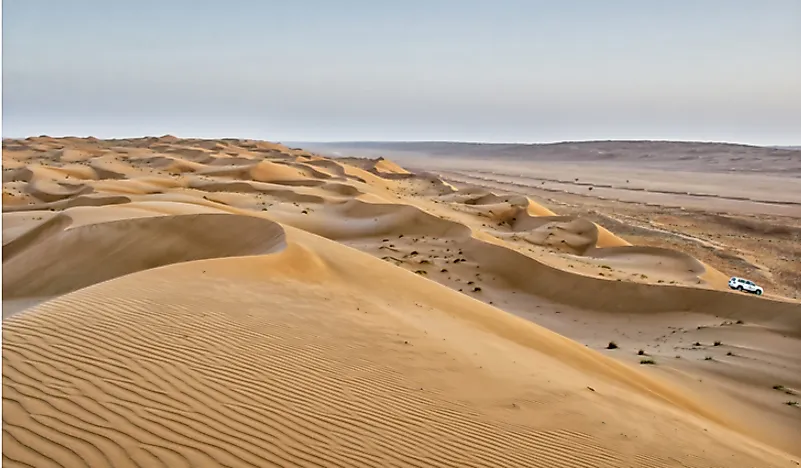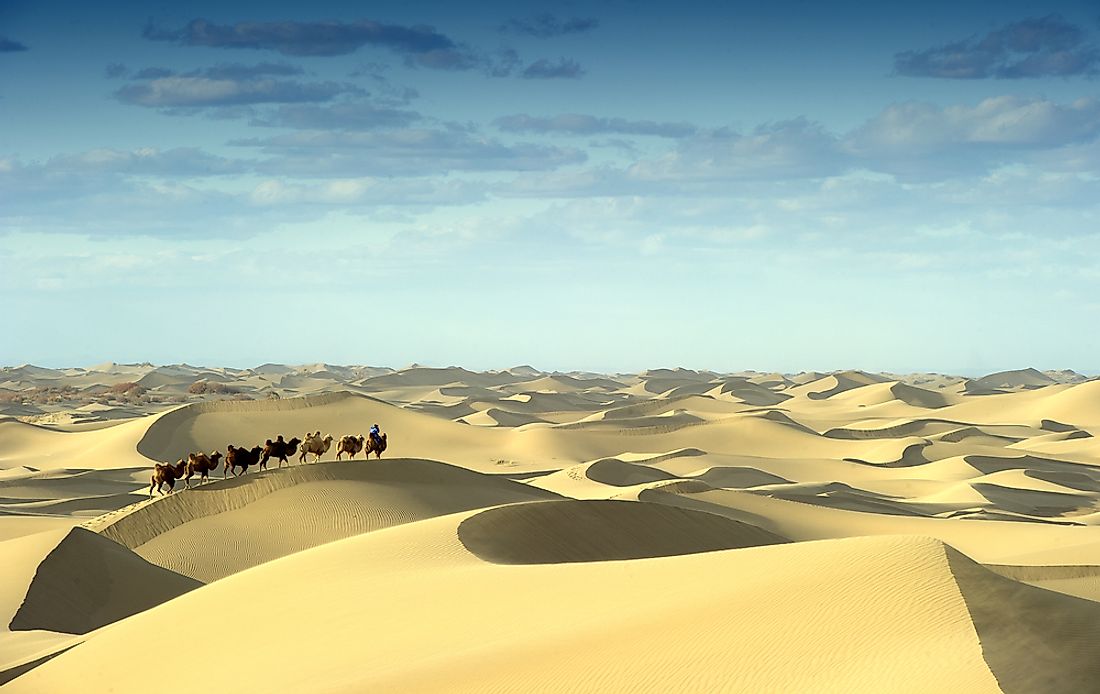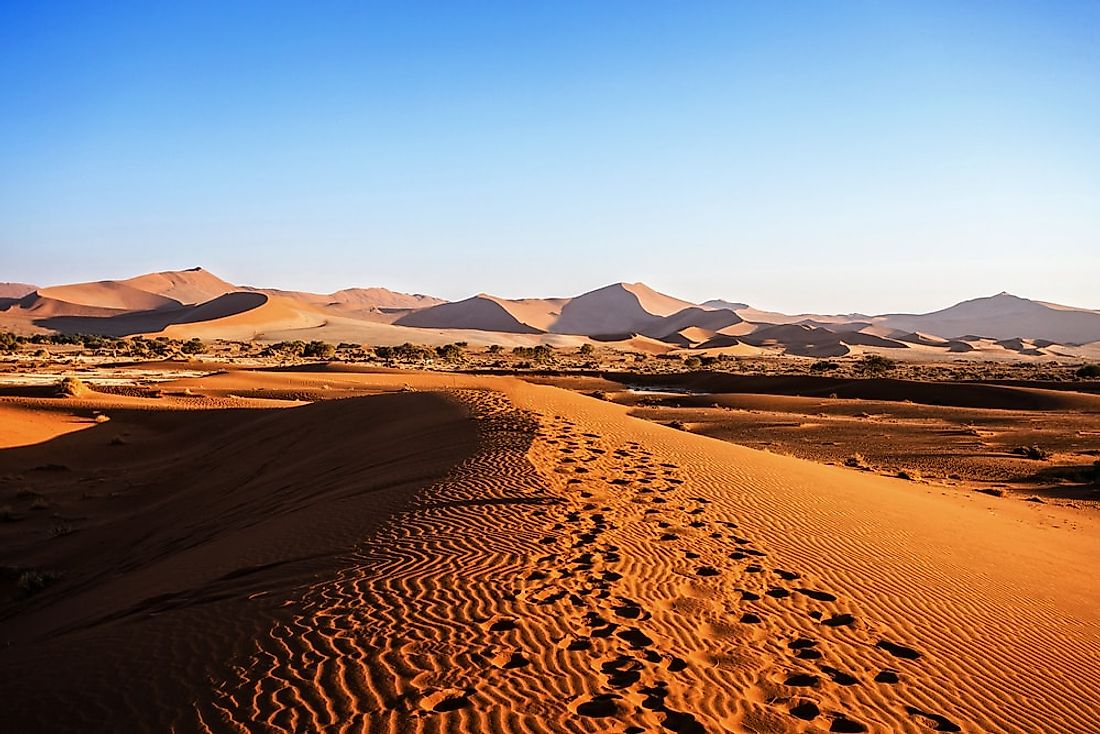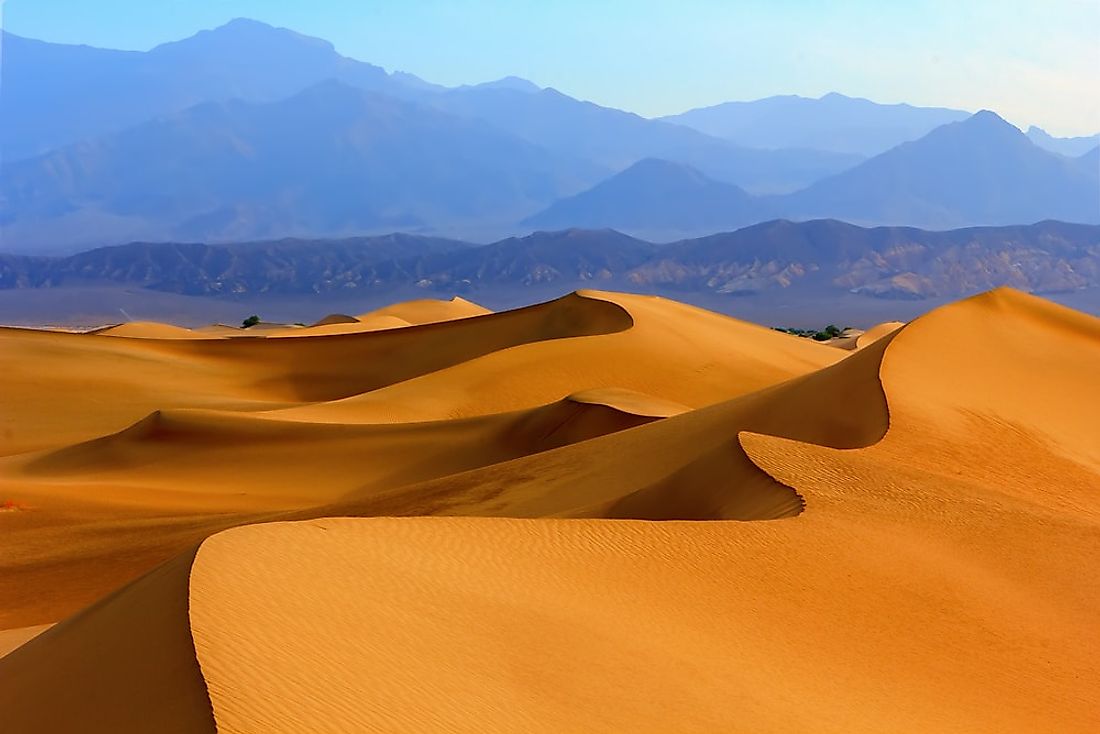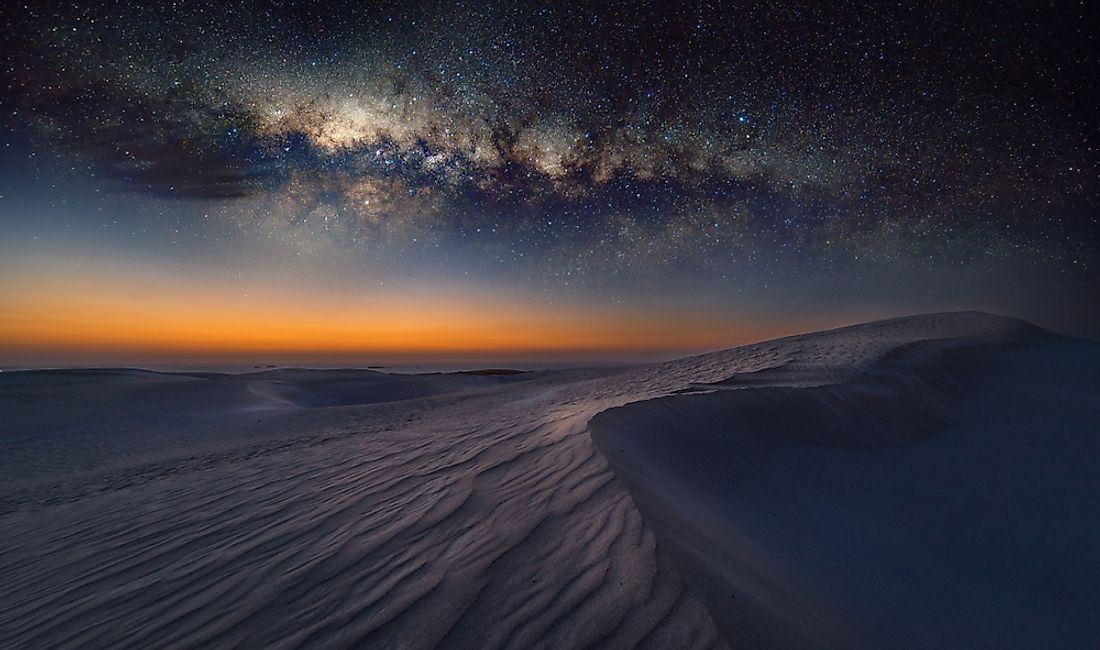Sand dunes are rarely isolated. They form in large groups known as dune fields, whispering in the desert wind or flowing with the water on a seabed.
Now researchers have discovered that dunes communicate with their neighbors as they move across these landscapes — they can even push their neighbor dunes farther away, according to a paper published in the journal Physical Review Letters on Tuesday. The findings could help experts understand how dune movements affect infrastructure, which could be key in adapting to a changing climate.
It’s well known that sand dunes move around and that smaller dunes move faster than larger ones, said Nathalie Vriend, the paper’s senior author from Cambridge University’s BP Institute for Multiphase Flow. But researchers assumed that a pair of identical dunes would move together at the same speed.
Instead, identical dunes that start close repel each other, moving farther away over time.
«They’re definitely communicating,» Vriend said in an interview with The Washington Post. «If I give my neighbor in front of me a push, it’s something I do. But we’re not talking about humans with brains, we’re talking about sand dunes that communicate — inanimate objects communicating information.»
Here’s what’s happening: When a water or wind flow hits a dune, a disturbance is created — almost like the wake created by a boat — and that disturbance gives the neighboring dune a little push, causing that dune to accelerate.
As the flow continues, that same movement also continues until the downstream dune is far enough away not to be affected by the wake.
«Similar to if you’re far enough from the boat, you wouldn’t feel the wake as much,» Vriend said.
A small amount of sand may be exchanged as the dunes move. But that’s a consequence of the movement, and it’s the energy from the wind or water flow creating the disturbance.
In the lab, Vriend said Karol Bacik, the report’s lead author from Cambridge University’s GK Batchelor Lab, plopped sand heaps into a rotating tank with water. The experiment was meant to mirror what happens in nature, but much faster.
She described field work in the desert in Qatar, where an approximately 16-foot high dune may move at the speed of about 65 feet per year, or a 98-foot high dune moves at 16 feet per year. By comparison, the sand heaps in the lab moved at about 65 feet per hour.
«If you are using satellite images to look at these interactions, it would take a long time to see these interactions happening. That’s why we decided to bring it into the lab and put it in fluid,» she said.
On a warming planet, understanding how sand dunes move could become even more important for understanding their impact on dry climates.
Vriend said climate-fueled desertification and an increased prevalence of sand dunes can harm roads and infrastructure. She recalled reading about creeping sand dunes in Nouakchott, Mauritania, where «parts of the city were engulfed by sand dunes — that’s impacting people directly, destroying their livelihoods.»
«I’m a physicist, a geoscientist, but I’m trying to contribute to these types of big questions,» Vriend said.
KEEP READING
- Подробности
-
24290
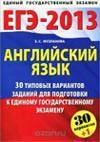 |
||
|
Прочитайте текст с пропусками, обозначенными номерами. Эти номера соответствуют заданиям А22-А28, в которых представлены возможные варианты ответов. Обведите номер выбранного вами варианта ответа. TEST 02 ( part 3) |
The Archipelago
In the remote southern seas there is a cluster of islands. Each island is inhabited by a different race of people. Although physically they look alike, you can tell them A22 ……………. by their styles of dress and their distinctive dialects. Each island has its own unique form of architecture. The only similarity between them is that each race builds in a manner that is A23 ……………. odds with the environment. On rocky hillsides there are wooden huts and in wooded valleys you can see towns of brick. Arid uplands are irrigated and planted with leafy gardens, whereas, on fertile plains, the parks are paved with stone. A24 ……………. their differences, the islanders coexist peacefully. There is rivalry over certain fishing waters but it rarely A25 ……………. to more than a few heated exchanges.
At the centre of the archipelago, perhaps in the most favoured spot of all, lies an island that has been deserted for many generations. It looks very different from the rest: darker, taller, silent. There is no obvious reason A26 ……………. its abandonment as it has good soil and plenty of freshwater.
Long ago, it was inhabited by farmers and fishermen much like everywhere else in the archipelago, but everything changed when they started building the first wall. As soon as it was finished a second circle of battlements began to rise from the centre, slightly narrower than the one before, so that from faraway the island A27 ……………. an enormous wedding cake.
Nobody can explain why the wall was started but there are many theories as to why it was never finished. Some say that so many had perished during its construction, that no one dared halt the work and thereby admit that it had all been in vain. Others claim that the builders simply A28 ……………. out of materials. But one thing is certain, the predicted threat never arrived and the people at the centre of the archipelago had, quite simply, bricked themselves in.
|
A22 |
1) out |
2) off |
3) apart |
4) aside |
|
A23 |
1) over |
2) at |
3) against |
4) on |
|
A24 |
1) Despite |
2) In spite |
3) Besides |
4) Although |
|
A25 |
1) raises |
2) attains |
3) amounts |
4) achieves |
|
A26 |
1) with |
2) to |
3) of |
4) for |
|
A27 |
1) recollected |
2) reminded |
3) resembled |
4) remembered |
|
A28 |
1) went |
2) ran |
3) grew |
4) came |
1) Вставьте слово, чтобы оно грамматически соответствовало содержанию текста.
Choosing a Career
Jane had always wanted to be a nurse and help ___ (PERSON) in need. Her father, however, thought that nursing was not a suitable profession for her.
2) Вставьте слово, чтобы оно грамматически соответствовало содержанию текста.
When she left school, she ___ (OFFER) a job as a doctor’s receptionist.
3) Вставьте слово, чтобы оно грамматически соответствовало содержанию текста.
Jane ___ (NOT WANT) to take the job, so she decided to talk to her friend Ann about what she should do. When Jane came to Ann’s house, Ann met her in the garden. ‘Hello,
4) Вставьте слово, чтобы оно грамматически соответствовало содержанию текста.
Jane! You look so unhappy! What ___ (THINK) (you) about?’
5) Вставьте слово, чтобы оно грамматически соответствовало содержанию текста.
While Jane ___ (EXPLAIN) her problem, Ann’s mother shouted to the girls to come over.
6) Вставьте слово, чтобы оно грамматически соответствовало содержанию текста.
She said that Jane’s father ___ (HAVE) an accident and he was in hospital.
7) Вставьте слово, чтобы оно грамматически соответствовало содержанию текста.
When they arrived at the hospital, Jane was amazed to see her father ___ (SIT) on the bed in a very good mood. ‘Oh, Jane, the nurses here are really wonderful. And I think…’ Jane smiled. She knew what her father was going to tell her.

Edinburgh
Edinburgh is one of the most written about cities on earth. Built on ancient volcanoes and first established because of its secure and ___ (DEFENCE) position, the capital of Scotland has become a crossroads.
9) Вставьте слово, чтобы оно грамматически и лексически соответствовало содержанию текста.
___ (PRACTICAL) everyone who comes to Scotland today spends some time in this city.
10) Вставьте слово, чтобы оно грамматически и лексически соответствовало содержанию текста.
Edinburgh is the second most popular tourist destination in Great Britain and it’s not hard to see why. Its midsummer ___ (NATION) festival is one of the biggest in the world.
11) Вставьте слово, чтобы оно грамматически и лексически соответствовало содержанию текста.
Edinburgh is a delight to explore on foot: most of its ___ (ATTRACT) are contained within a compact central area.
12) Вставьте слово, чтобы оно грамматически и лексически соответствовало содержанию текста.
With streets steeped in history and a thriving ___ (CULTURE) scene, Edinburgh offers the perfect balance between traditional and contemporary things.
13) Вставьте слово, чтобы оно грамматически и лексически соответствовало содержанию текста.
The area around the city has many ___ (HISTORY) towns and scenic villages, which are also great for exploring.
14) Запишите в поле ответа цифру 1, 2, 3 или 4, соответствующую выбранному Вами варианту ответа.
The Archipelago
In the remote southern seas there is a cluster of islands. Each island is inhabited by a different race of people. Although physically they look alike, you can tell them ___ by their styles of dress and their distinctive dialects.
1) out
2) off
3) apart
4) aside
15) Запишите в поле ответа цифру 1, 2, 3 или 4, соответствующую выбранному Вами варианту ответа.
Each island has its own unique form of architecture. The only similarity between them is that each race builds in a manner that is ___ odds with the environment.
1) over
2) at
3) against
4) on
16) Запишите в поле ответа цифру 1, 2, 3 или 4, соответствующую выбранному Вами варианту ответа.
On rocky hillsides there are wooden huts and in wooded valleys you can see towns of brick. Arid uplands are irrigated and planted with leafy gardens, whereas, on fertile plains, the parks are paved with stone. ___ their differences, the islanders coexist peacefully.
1) Despite
2) In spite
3) Besides
4) Although
17) Запишите в поле ответа цифру 1, 2, 3 или 4, соответствующую выбранному Вами варианту ответа.
There is rivalry over certain fishing waters but it rarely ___ to more than a few heated exchanges.
1) raises
2) attains
3) amounts
4) achieves
18) Запишите в поле ответа цифру 1, 2, 3 или 4, соответствующую выбранному Вами варианту ответа.
At the centre of the archipelago, perhaps in the most favoured spot of all, lies an island that has been deserted for many generations. It looks very different from the rest: darker, taller, silent. There is no obvious reason ___ its abandonment as it has good soil and plenty of freshwater.
1) with
2) to
3) of
4) for
19) Запишите в поле ответа цифру 1, 2, 3 или 4, соответствующую выбранному Вами варианту ответа.
Long ago, it was inhabited by farmers and fishermen much like everywhere else in the archipelago, but everything changed when they started building the first wall. As soon as it was finished a second circle of battlements began to rise from the centre, slightly narrower than the one before, so that from faraway the island ___ an enor- mous wedding cake.
1) recollected
2) reminded
3) resembled
4) remembered
20) Запишите в поле ответа цифру 1, 2, 3 или 4, соответствующую выбранному Вами варианту ответа.
Nobody can explain why the wall was started but there are many theories as to why it was never finished. Some say that so many had perished during its construction, that no one dared halt the work and thereby admit that it had all been in vain. Others claim that the builders simply ___ out of materials. But one thing is certain, the predicted threat never arrived and the people at the centre of the archipelago had, quite simply, bricked themselves in.
1) went
2) ran
3) grew
4) came
Even though they are inanimate objects, sand dunes can ‘communicate’ with each other. A team from the University of Cambridge has found that as they move, sand dunes interact with and repel their downstream neighbours.
Using an experimental dune ‘racetrack’, the researchers observed that two identical dunes start out close together, but over time they get further and further apart. This interaction is controlled by turbulent swirls from the upstream dune, which push the downstream dune away. The results, reported in the journal Physical Review Letters, are key for the study of long-term dune migration, which threatens shipping channels, increases desertification, and can bury infrastructure such as highways.
When a pile of sand is exposed to wind or water flow, it forms a dune shape and starts moving downstream with the flow. Sand dunes, whether in deserts, on river bottoms or sea beds, rarely occur in isolation and instead usually appear in large groups, forming striking patterns known as dune fields or corridors.
It’s well-known that active sand dunes migrate. Generally speaking, the speed of a dune is inverse to its size: smaller dunes move faster and larger dunes move slower. What hasn’t been understood is if and how dunes within a field interact with each other.
«There are different theories on dune interaction: one is that dunes of different sizes will collide, and keep colliding, until they form one giant dune, although this phenomenon has not yet been observed in nature,» said Karol Bacik, a Ph.D. candidate in Cambridge’s Department of Applied Mathematics and Theoretical Physics, and the paper’s first author. «Another theory is that dunes might collide and exchange mass, sort of like billiard balls bouncing off one another, until they are the same size and move at the same speed, but we need to validate these theories experimentally.»
Now, Bacik and his Cambridge colleagues have shown results that question these explanations. «We’ve discovered physics that hasn’t been part of the model before,» said Dr. Nathalie Vriend, who led the research.
Most of the work in modelling the behaviour of sand dunes is done numerically, but Vriend and the members of her lab designed and constructed a unique experimental facility which enables them to observe their long-term behaviour. Water-filled flumes are common tools for studying the movement of sand dunes in a lab setting, but the dunes can only be observed until they reach the end of the tank. Instead, the Cambridge researchers have built a circular flume so that the dunes can be observed for hours as the flume rotates, while high-speed cameras allow them to track the flow of individual particles in the dunes.
Bacik hadn’t originally meant to study the interaction between two dunes: «Originally, I put multiple dunes in the tank just to speed up data collection, but we didn’t expect to see how they started to interact with each other,» he said.
The two dunes started with the same volume and in the same shape. As the flow began to move across the two dunes, they started moving. «Since we know that the speed of a dune is related to its height, we expected that the two dunes would move at the same speed,» said Vriend, who is based at the BP Institute for Multiphase Flow. «However, this is not what we observed.»
Initially, the front dune moved faster than the back dune, but as the experiment continued, the front dune began to slow down, until the two dunes were moving at almost the same speed.
Crucially, the pattern of flow across the two dunes was observed to be different: the flow is deflected by the front dune, generating ‘swirls’ on the back dune and pushing it away. «The front dune generates the turbulence pattern which we see on the back dune,» said Vriend. «The flow structure behind the front dune is like a wake behind a boat, and affects the properties of the next dune.»
As the experiment continued, the dunes got further and further apart, until they form an equilibrium on opposite sides of the circular flume, remaining 180 degrees apart.
The next step for the research is to find quantitative evidence of large-scale and complex dune migration in deserts, using observations and satellite images. By tracking clusters of dunes over long periods, we can observe whether measures to divert the migration of dunes are effective or not.
More information:
Wake induced long range repulsion of aqueous dunes, Physical Review Letters (2020). doi.org/10.1103/PhysRevLett.124.054501
Citation:
Sand dunes can ‘communicate’ with each other (2020, February 4)
retrieved 10 March 2023
from https://phys.org/news/2020-02-sand-dunes.html
This document is subject to copyright. Apart from any fair dealing for the purpose of private study or research, no
part may be reproduced without the written permission. The content is provided for information purposes only.
Sand dunes are part of nature’s scintillating creations. They are mounds formed by loose grains of sand blown by the wind and gathered in one place creating a small hill. Sand dunes cannot be formed without sand and wind. Most sand dunes form in deserts and sandy beaches. Enormous sand dunes in the Sahara Desert are called sand seas. Understanding the types of sand dunes and their formation assists in the development of infrastructures like gas and oil fields. It also helps in controlling the movement of sand. Subsequently, the five major types of sand dunes are Star, linear, parabolic, barchan, and reversing sand dunes. The velocity, turbulence, and direction of wind determine the types of sand dunes formed. Also, the amount of sand available also influences the kind of sand dune formed. The star sand dunes are pyramid-shaped. They form in places with multidirectional and strong wind regimes. Furthermore, they need large amounts of sand for their formation. The star dunes grow upwards and outwards. They have three or more ridges that radiate from a center point. The slip face of star sand dunes keeps changing direction depending on the flow of wind. Besides their pyramid shape, the star dunes are the tallest sand dunes on the earth. For instance, the star dunes in Badain Jaran Desert in China grow up to 500 meters tall. An example of star dunes is in the Grand Erg Oriental of the Sahara desert. In other deserts, the star dunes form near topographic barriers around margins of the sand seas. Star dunes form 8.5% of the world’s total sand dunes. Other places which exhibit the presence of star sand dunes include Gran Desierto de Altar in Mexico and the eastern Rub’al Khali located in the Arab peninsula. The linear sand dunes are the longest type of sand dunes in the world. They may grow as long as 120 to 200 km such as those found in the Sahara Desert. Also, they are straight, regular-spaced, and snake-like in shape. A prominent feature of the linear sand dunes is the ridges. The dunes appear as isolated and large symmetrical peaks. Miles of gravel, sand, and rocky interdune corridors separate them from each other. Apart from the straight shape, some linear sand dunes combine to form Y-shaped compound dunes. The linear sand dunes require strong winds from two directions for their creation. As such, they form in the presence of both the primary wind and cross-wind directions. Simply put, the linear dunes form in bidirectional wind regimes. Most of them form in desert places where there is barren ground between the dunes. Furthermore, the linear sand dunes possess long axes that extend in the direction of the movement of the sand. A parabolic sand dune is an inverted crescent-shaped dune that has vegetation-anchored tips. Sometimes, it seems like it is U-shaped. The tips of the parabolic dune point towards the upwind direction. On the other hand, its steep slip face points to the downwind side. The longest known parabolic dune ever recorded has a trailing arm almost 12 km long. Parabolic dunes form when little vegetation begins to grow on the ends of a sand dune. Its formation requires moderate amounts of sand and strong winds. Most parabolic sand dunes form near lake shore areas known as the “seas.” Other names referring to the parabolic sand dune are U-shaped, blowout, and hairpin dunes. One can find these dunes in coastal deserts. A barchan sand dune is a crescent-shaped dune. It has a steep slip face whose tips point away from the wind. The dunes are separated from each other and keep moving along the surface of the barren deserts. In most cases, the creation of barchans takes place where there are limited portions of sand. In fact, deserts that experience many barchan dunes are inland and open like Turkistan Desert. Barchans are the most common sand dune compared to the other sand dunes found both on Earth and Mars. Their sizes are more wide than long. They can be 9-30 m long and 370 m wide. The barchans form where the winds blow consistently from one direction. They move faster over the desert surfaces than any other dunes-hence they are the fastest moving sand dunes that ever existed. The speed of the barchans may range from 1-100 meters per year. For instance, in China’s Ningxia Province, a group of dunes moved for about 100m per year from 1954-1959. The Western Desert in Egypt also has a history of barchans traversing the desert in speeds close to the dunes in Ningxia Province in China. The largest barchans on Earth are in Taklamakan Desert in China. Barchans also exist in sea beaches such as the Peru beach. Other names for the barchans are transverse dunes and crescentic dunes. Alexander von Middendorf is credited with introducing the word barchan into the scientific literature in 1881. Reversing sand dunes can be found in areas where the wind periodically changes direction or reverses its direction. The winds blowing in the opposite directions have a balanced combination of duration and strength. An example of a reversing sand dune is in the Algodones, California. These dunes form where sediment supply is abundant. An attractive feature of the reversing sand dunes is the “Chinese Walls” that builds on top of the dunes. The reversing dunes form by having variations of the other sand dunes mostly the star and the transverse sand dunes. The reversing sand dunes can move horizontally to a limited distance due to the seasonal shifts in the wind direction. They have two slip faces: the primary and secondary slip faces. The secondary slip face points to the opposite direction as the primary slip face. The sand dune grows vertically. 5. Star
4. Linear
3. Parabolic
2. Barchan
1. Reversing

A
One of the main problems posed by sand dunes is their encroachment on human habitats. Sand dunes move by different means, all of them aided by the wind. Sand dunes threaten buildings and crops in Africa, the Middle East, and China. Preventing sand dunes from overwhelming cities and agricultural areas has become a priority for the United Nations Environment Program. On the other hand, dune habitats provide niches for highly specialized plants and animals, including numerous rare and endangered species.
B
Sand is usually composed of hard minerals such as quartz that cannot be broken down into silt or clay. Yellow, brown and reddish shades of sand indicate their presence of iron compounds. Red sand is composed of quartz coated by a layer of iron oxide. White sands are nearly pure gypsum. Sand with a high percentage of silicate can be used in glassmaking. Sandstone is created by sand, mixed with lime, chalk or some other material that acts as a binding agent, that is deposited in layers at the bottom of a sea or other area and pressed together into rock by the great pressure of sediments that are deposited on top of it over thousands or millions of years.
C
The most common dune form on Earth and on Mars is crescentic. Crescent-shaped mounds are generally wider than they are long. The slipfaces are on the concave sides of the dunes. These dunes form under winds that blow consistently from one direction, and they also are known as barchans or transverse dunes. Some types of crescentic dunes move more quickly over desert surfaces than any other type of dune. A group of dunes moved more than 100 metres per year between 1954 and 1959 the China’s Ningxia Province, and similar speeds have been recorded in the Western Desert of Egypt. The largest crescentic dunes on Earth, with mean crest-to-crest widths of more than 3 kilometres, are in China’s Taklamakan Desert.
D
Radially symmetrical, star dunes are pyramidal sand mounds with slipfaces on there or more arms that radiate from the high center of the mound. They tend to accumulate in areas with multidirectional wind regimes. Star dunes grow upward rather than laterally. They dominate the Grand Erg Oriental of the Sahara. In other deserts, they occur around the margins of the sand seas, particularly near topographic barriers. In the southeast Badain Jaran Desert of China, the star dunes are up to 500 metres tall and may be the tallest dunes on Earth. Straight or slightly sinuous sand ridges typically much longer than they are wide are known as linear dunes. They may be more than 160 kilometres (99 mi) long. Some linear dunes merge to form Y-shaped compound dunes. Many forms in bidirectional wind regimes. The long axes of these dunes extend in the resultant direction of sand movement. Linear loess hills known as pahas are superficially similar.
E
Once sand begins to pile up, ripples and dunes can form. Wind continues to move sand up to the top of the pile until the pile is so steep that it collapses under its own weight. The collapsing sand comes to rest when it reaches just the right steepness to keep the dune stable. This angle, usually about 30-34°, is called the angle of repose. Every pile of loose particles has a unique angle of repose, depending upon the properties of the material it’s made of, such as the grain size and roundness. Ripples grow into dunes with the increase of wind and sand input.
F
The repeating cycle of sand inching up the windward side to the dune crest, then slipping down the dune’s slip face allows the dune to inch forward, migrating in the direction the wind blows. As you might guess, all of this climbing then slipping leaves its mark on the internal structure of the dune. The image on the right shows fossil sand dune structure preserved in the Merced Formation at Fort Funston, Golden Gate National Recreation Area. The sloping lines or laminations you see are the preserved slip faces of a migrating sand dune. This structure is called cross-bedding and can be the result of either wind or water currents. The larger the cross-bedded structure, however, the more likely it is to be formed by wind, rather than water.
G
Sand dunes can “sing” at a level up to 115 decibels and generate sounds in different notes. The dunes at Sand Mountain n Nevada usually sing in a low C but can also sing in B and C sharp. The La Mar de Dunas in Chile hum in F while those at the Ghord Lahmar in Morocco howl in G sharp. The sounds are produced by avalanches of sand generated by blowing winds. For a while, it was thought that the avalanches caused the entire dune to resonate like a flute or violin but if that were true then different size dunes would produce different notes. In the mid 2000s, American, French and Moroccan scientists visiting sand dunes in Morocco, Chile, China and Oman published a paper in the Physical Review Letters that determined the sounds were produced by collisions between grains of sand that caused the motions of the grains to become synchronized, causing the outer layer of a dune to vibrate like the cone of a loudspeaker, producing sound. The tone of the sounds depended primarily on the size of the grains.
H
Scientists performed a computer simulation on patterns and dynamics of desert dunes in laboratory. Dune patterns observed in deserts were reproduced. From the initial random state, stars and linear dunes are produced, depending on the variability of the wind direction. The efficiency in sand transport is calculated through the course of development. Scientists found that the sand transport is the most efficient in the linear transverse dune. The efficiency in sand transport always increased through the evolution, and the way it increases was stepwise. They also found that the shadow zone, the region where the sand wastes the chance to move, shrinks through the course of evolution, which greatly helps them build a model to simulate a sand move.
Questions 1-8
Choose the correct heading for paragraphs A-H from the list below.
Write the correct number, i-x, in boxes 1-8 on your answer sheet.
List of Headings
i potential threat to buildings and crops despite of benefit.
ii the cycle of sand moving forward with wind
iii protection method in various countries.
iv scientists simulate sand move and build model in lab
v sand composition explanation
vi singing sand dunes
vii other types of sand dunes
viii the personal opinion on related issues.
ix reasons why sand dunes form
x the most common sand type
1 Paragraph A
Answer: i
2 Paragraph B
Answer: v
3 Paragraph C
Answer: x
4 Paragraph D
Answer: vii
5 Paragraph E
Answer: ix
6 Paragraph F
Answer: ii
7 Paragraph G
Answer: vi
8 Paragraph H
Answer: iv
Questions 9-10
Answer the questions 9-10 and choose correct letter A, B, C or D.
9. What is the main composition of white sand made of according to the passage?
A Quartz
B Gypsum
C Lime
D Iron
Answer: B
10. Which one is not mentioned as a sand type in this passage?
A Linear
B Crescentic
C Overlap
D Star
Answer: C
Questions 11-14
Complete the summary using the list of words, A-J below.
Write the correct letter, A-J in boxes 11-14 on your answer sheet.
Crescentic is an ordinary 11
Answer: B on both Earth and Mars, apart from which, there are also other types of sand dunes. Different color of the sand reflects different components, some of them are rich in 12
Answer: G that can not be easily broken into clay. Sand dunes can “sing” at a level up to 115 decibels and generate sounds in different notes. Sand dunes can be able to 13
Answer: H at a certain level of sound intensity, and the different size of grains creates different 14
Answer: D of the sounds.
A quartz B shape C pressure
D tone E protection F category
G minerals H sing I lab
J direction
Добавил:
Vezen
Опубликованный материал нарушает ваши авторские права? Сообщите нам.
Вуз:
Предмет:
Файл:
Скачиваний:
27753
Добавлен:
20.06.2014
Размер:
2.46 Mб
Скачать

|
Practice Test 12 |
ЧАСТЬ 1 – АУДИРОВАНИЕ |
3Вы услышите девушку, рассказывающую о своём путешествии в Южную Америку. В заданиях А8–А14 обведите цифру 1, 2 или 3, соответствующую номеру выбранного вами варианта ответа. Вы услышите запись дважды.
14A8 The narrator wanted to go to South America because 1 she had enjoyed working on a project about it.
2 she wanted to see the nature there. 3 her father had told her a lot about it.
15A9 The narrator’s parents were worried that she 1 would get homesick while she was away. 2 wouldn’t come back from South America. 3 wanted to travel by herself.
16A10 The narrator says that she was surprised by
1 how well she did in her exams.
2 how long her trip took to plan.
3 how relaxed her parents were about the trip.
17A11 The narrator decided to do volunteer work because 1 some friends recommended it to her.
2 she thought it would be the most enjoyable way to spend her time. 3 she thought it would impress future employers.
18A12 Regarding her time in the mountain village, the narrator suggests that 1 it passed very quickly.
2 she would have liked to stay longer.
3 it had made her want to become a teacher.
19A13 The narrator says that she is glad that, while on her trip, she 1 spent time getting to know the locals.
2 knew how to speak some Spanish.
3 visited every country in South America.
20A14 Now that she is back from her trip, the narrator 1 is keen to travel again.
2 is recovering from an illness she caught in South America. 3 is considering going to university in South America.
93

|
ЧАСТЬ 2 – ЧТЕНИЕ |
Practice Test 12 |
1Установите соответствие между заголовками A–Н и текстами 1–7. Занесите свои ответы в таблицу B2. Используйте каждую букву только один раз. В задании один заголовок лишний.
A A better method
B Responsible shopping
C Lucky winners
DHelp from nature
1 Two families – one from London, and one from Liverpool – have won last night’s national lottery. Speaking from outside their home in London’s East End, Mr and Mrs Miller said that they will ‘not let the money change their lives’ and that they will both be at work as usual on Monday morning. The Liverpool family, who do not wish to be named, plan to move abroad.
2 For many years now, Changi Airport in Singapore has been voted the world’s best airport by airline travellers. Changi Airport does not simply provide travellers with wonderful restaurants and shops in a calm and pleasant atmosphere. You can also swim in its rooftop swimming pool, have a massage in one of its spas, sit quietly in the ‘garden’ area of its main hall, or watch TV in comfortable chairs while waiting for your flight.
3Before the invention of the compass, sailors looked to the sun in the daytime and to the stars at night to help them find their way across the oceans. For example, by locating Polaris (or ‘the North Star’) in the night sky, sailors could identify the direction of North. This is because Polaris never moves from its position in the night sky directly above the North Pole.
4Long ago, zoos obtained their animals by going out into the wild and capturing them. Today, this happens very rarely. For one thing, it is extremely stressful for the animals involved and there is a high risk of injury.
E A great shopping experience
F Working to protect animals
G Everything you need
H Waiting in comfort
Also, wild animals often carry diseases that would harm the other animals in the zoo. Today, therefore, most zoos get their animals from the captive breeding programmes of other zoos.
5Gyms these days are full of all kinds of fancy exercise equipment; treadmills, rowing machines, exercise bikes, resistance machines and much more. But the biggest gyms also have swimming pools, steam rooms and cafeterias. They offer classes in yoga, dance, aerobics and many other forms of exercise. And they have expert trainers on hand to answer all your fitness questions.
6Here is one thing that we can all do to help species that are close to extinction. When travelling overseas, be very careful not to buy any souvenirs that have been made from species nearing extinction. This means avoiding purchasing items made from ivory, coral and fur and also ‘medicinal’ products as they often contain rhino, tiger and bear parts.
7Wildlife parks and zoos are very educational places but perhaps their greatest purpose is the conservation of endangered species. Animal centres all around the world work together in order to breed rare and endangered species. For example, today there are only a few hundred giant pandas left in the wild. If breeding programmes and conservation efforts are successful, future generations may still be able to see these beautiful animals in the flesh, not just in books.
|
1 |
2 |
3 |
4 |
5 |
6 |
7 |
|
B2 C |
H |
D |
A |
G |
B |
F |
94

|
Practice Test 12 |
ЧАСТЬ 2 – ЧТЕНИЕ |
2 Прочитайте текст и заполните пропуски 1–6 частями предложений, обозначенными буквами A–G. Одна из частей в списке А–G лишняя. Занесите букву, обозначающую соответствующую часть предложения, в таблицу B3.
In 2004, a grave containing the skeletons of a human and a cat, lying close together, was excavated in Cyprus.
The grave was around 9,500 years old, 1) …….. .
The ancient Egyptians kept cats as pets,
2) …….. .
People often placed statues of cats outside their homes, 3) …….. . When a cat died, their former owners and the other occupants of the house would go into deep mourning and would often even shave their eyebrows as a sign of grief.
Moreover, cats were frequently mummified and bowls of milk and dead rats and mice were placed in their tombs, 4) …….. .
Awhich seems very strange to modern cultures
Band showed that cats had been kept by humans for far longer than we had previously thought
Cso that they would have food for their journey into the afterlife
Das they kept rats and mice away from homes
Cats were so respected in ancient Egypt that they were even protected by law. People could be sentenced to death if they killed a cat, 5) …….. .
One record documents the execution of an unfortunate Roman soldier whose chariot had run over a cat.
There are many tomb scenes that show cats as part of everyday life in ancient Egypt. They often showed them wearing jewellery including earrings, necklaces and fancy collars. The Egyptians even took their cats on hunting expeditions, 6) …….. .
Today, it is estimated that there are over 600 million domestic cats around the world, which makes the cat the most popular of all pets. However, the cat no longer has any religious significance in any culture.
Eand they also worshipped the cat like one of their gods
Fbecause they believed that this would protect the inhabitants
G even by accident
|
1 |
2 |
3 |
4 |
5 |
6 |
|
B3 B |
E |
F |
C |
G |
A |
95

|
ЧАСТЬ 2 – ЧТЕНИЕ |
Practice Test 12 |
3Прочитайте рассказ и выполните задания А15–А21. В каждом задании обведите цифру 1, 2, 3 или 4, соответствующую выбранному вами варианту ответа.
A New Life
“Are you looking for a room?” the man had asked. We’d only just got off the bus. Ian was still pulling the bags out of the luggage
prices,” the man
A15
We’d been all around the country that summer, finding temporary work to pay for our travels. Ian had grown up in a village, so
A16
the local farmers had been happy to hire him to help them out for a week or two. I’m a city boy myself, but because I’m pretty well-built I didn’t have a problem either. Of course, that meant that I got all the heavy work!
Once we had collected our bags, we followed the man up a nearby side-street. He didn’t stop talking the whole way. After a few twists
That first night we strolled around the town to see what opportunities there might be for work. Our last job had given us enough to live off for a few weeks so we weren’t desperate,
A19
possible. Everyone we met was very friendly and we went back to our rooms feeling quite optimistic.
Within a couple of days, I had started work
at a fish restaurant in the town washing up the
A20
pots and dishes. Maybe it wasn’t the best job in the world, but after weeks of manual labour in the fields it was a welcome change. I could watch the chef preparing the food and sometimes, when the restaurant was particularly busy, I would help him. He knew
these rooms would be too expensive for us. The man must have read my thoughts. “Now, normally I’d be asking twice as much for these rooms,” he began, “but you’re in luck because the tourist season is practically over.”
The rooms were perfect. The décor was slightly shabby but, as if to make up for it, the balcony had a stunning view over the town. We decided to stay for a month initially, and depending on what happened, we would come to an arrangement after that. It was a relief to be settled somewhere, if only for a few weeks. I could now pack my suitcase in record time and we’d met so many people that I’d lost count. Sometimes when I was introduced to yet another stranger I would change my name, just to make it more interesting.
tasted amazing. I’d go home at night and write down the recipes and tips that I’d learnt.
Our first month in the town came to an end and we decided to stay for another three. Ian had found some painting and decorating work and I was quite happy. Those three months turned into six, and before I knew it I had been at the restaurant for a whole year. The chef asked me if I would like to become his assistant — he said I had a natural gift for cooking. So that’s how I ended up here, ten years later, as Head Chef at Alberto’s Fish
Restaurant. Ian is still here as well, running
A21
his own decorating business. One day I hope to achieve something similar for myself, too.
96

|
Practice Test 12 |
ЧАСТЬ 2 – ЧТЕНИЕ |
|||
|
The man waiting at the bus stop was very |
||||
|
14 |
||||
|
A15 |
1 |
|||
|
rude. |
||||
|
2 |
impatient. |
|||
|
3 |
unhelpful. |
|||
|
4 |
persistent. |
15A16 The farmers gave the narrator and his friend Ian work because
1 they thought they would be suitable for it.
2 they needed seasonal workers.
3 they had known Ian since he was young.
4 they found both boys cheerful and friendly.
16A17 The narrator thought the rooms could be too expensive after he realised 1 how popular they were.
2 what time of year it was.
3 how nice the exterior was.
4 where they were.
17A18 In paragraph four, the narrator suggests that he had become tired of 1 staying in hotels.
2 packing his suitcase.
3 moving from place to place.
4 meeting new people.
18A19 In paragraph five, the narrator uses the phrase ‘put out feelers’ to mean 1 meet as many people as possible.
2 speak to people to get information about work.
3 find a suitable job to earn some money.
4 get to know a new place.
19A20 The narrator enjoyed his new job because 1 all his food was cooked for him.
2 it was different from his previous jobs.
3 his boss took an interest in teaching him to cook. 4 the time passed quickly.
20A21 In the final paragraph, we learn that the narrator 1 would like to start a business with Ian.
2 regrets staying so long at Alberto’s restaurant.
3 hopes that his career as a chef will continue to advance. 4 wishes that he had achieved as much as Ian.
97

ЧАСТЬ 3 – ГРАММАТИКА И ЛЕКСИКА Practice Test 12
1Прочитайте приведённый ниже текст. Преобразуйте, если необходимо, сло* ва, напечатанные заглавными буквами в конце строк, обозначенных номера* ми B4–B10, так, чтобы они грамматически соответствовали содержанию текста. Заполните пропуски полученными словами. Каждый пропуск соответствует отдельному заданию из группы B4–B10.
|
B4 |
was |
|
B5 |
was trying |
|
B6 |
will find |
|
B7 |
had passed |
|
B8 |
have been given |
|
|
B9 |
had left |
|
|
B10 |
fixed |
2 Прочитайте приведённый ниже текст. Преобразуйте, если необходимо, слова, напечатанные заглавными буквами в конце строк, обозначенных номерами В11–B16, так, чтобы они грамматически и лексически соответ* ствовали содержанию текста. Заполните пропуски полученными словами. Каждый пропуск соответствует отдельному заданию из группы В11–В16.
The Trans Siberian Railway
|
Travelling on the |
Trans Siberian |
Express is an |
extraordinary journey. It |
is the |
longest |
|||||
|
continuous |
||||||||||
|
B11 |
railway in the world — 10,000 kilometres long, or one third of the distance |
|||||||||
|
around |
the globe. |
Travellers on |
the Trans Siberian railway describe the |
journey |
as a(n) |
|||||
|
amazing |
||||||||||
|
B129) |
adventure; seven days or more of exotic travel from Moscow to Vladivostok. |
|||||||||
|
10)B13 |
conversation |
with other passengers that |
||||||||
|
However, many travellers say that it is the |
||||||||||
makes the journey special. You can spend many hours making new friends and discussing the
|
landscape of the Ural Mountains and Siberia. |
||||||||||
|
You can either stay on |
the |
train |
for the |
whole journey |
or, |
if |
you are |
feeling more |
||
|
1B14) |
adventurous |
, |
you |
can |
arrange |
stops along the |
way. |
A |
stopover |
at Irkutsk is |
|
recommended for a few days. Here you can explore the city and visit the |
12)B15 |
beautiful |
|
Lake Baikal; the deepest lake in the world. |
The journey ends on the east coast of Russia in Vladivostok, whose name means “Lord of the East”. However you decide to spend your time on the Trans Siberian Express, it will be an extremely
|
13)B16 |
memorable |
experience. |
CONTINUE
AMAZE CONVERSE
ADVENTURE BEAUTY
MEMORY
98

|
Practice Test 12 |
ЧАСТЬ 3 – ГРАММАТИКА И ЛЕКСИКА |
3Прочитайте текст с пропусками, обозначенными номерами А22–А28. Эти номера соответствуют заданиям A22–A28, в которых представлены возмож* ные варианты ответов. Обведите номер выбранного вами варианта ответа.
The Report Card
John had never been very good 14)A22…….. sports. He simply wasn’t an athletic kind of person. He knew it, his
friends knew it, and his gym teachers at school had known it, too. On his school report for the year 1992, his
|
Physical Education teacher had written: ‘John tries very |
……..15)A23 |
in class, but achieves below average results.’ |
|||
|
The teacher had obviously thought that it would be a good idea to mention John’s effort, but he only |
|||||
|
16)A24…….. |
|||||
|
in emphasising his failure. |
|||||
|
As an adult in his |
thirties, John did everything he could to avoid playing any sort of sport. Whenever |
||||
|
17)A25……… |
his friends were trying to organise a friendly game of football, or his boss needed to find a tennis partner, John
would always 18)A26…….. an excuse. Once, he even faked an injury so that he didn’t have to take 19)A27…….. in
a basketball game. But it was only when John had to explain to his new girlfriend why he couldn’t play squash with
|
her that he decided that his problem with sports had gone on for long enough. It was |
……..20)A28 |
to change. |
|||||||||
|
A22 |
1 |
for |
2 |
at |
3 |
to |
4 |
on |
|||
|
A23 |
1 |
strongly |
2 |
well |
3 |
heavily |
4 |
hard |
|||
|
A24 |
1 |
achieved |
2 |
succeeded |
3 |
managed |
4 |
ended |
|||
|
A25 |
1 |
beginning |
2 |
young |
3 |
early |
4 |
opening |
|||
|
A26 |
1 |
make up |
2 |
find out |
3 |
put up |
4 |
think over |
|||
|
A27 |
1 |
position |
2 |
role |
3 |
place |
4 |
part |
|||
|
A28 |
1 |
time |
2 |
moment |
3 |
season |
4 |
point |
ЧАСТЬ 4 – ПИСЬМО
C11 You have received a letter from your English speaking pen friend Jack who writes:
… Well, my exams start next week and I’m feeling a little stressed even though I’ve studied hard. How often do you have exams at your school? Do you like taking exams? How do you
cope with the pressure?
It’s my best friend John’s birthday this weekend …
Write a letter to Jack. In your letter ● answer his questions
● ask 3 questions about his best friend’s birthday Write 100 140 words. Remember the rules of letter writing.
C22 Comment on the following statement.
“Extreme sports have become more and more popular. However, some say that they are too risky.”
What is your opinion? Does the thrill of the sport outweigh the risk? Write 200 250 words.
Use the following plan:
●write an introduction (state the problem/topic)
●express your personal opinion and give reasons for it
●give arguments for the other point of view and explain why you don’t agree with it
●draw a conclusion
99

|
ЧАСТЬ 1 – АУДИРОВАНИЕ |
Practice Test 13 |
1 Вы услышите высказывания шести людей о путешествиях. Установите соответствие между высказываниями каждого говорящего 1–6 и утверждениями, данными в списке A–G. Используйте каждое утверждение, обозначенное буквой,
только один раз. В задании есть одно лишнее утверждение. Вы услышите запись дважды. Занесите свои ответы в таблицу B1.
A I appreciate travelling for my job.
B I have found a way to travel quite cheaply.
C I don’t have to travel far to find what I want. D I prefer to travel by myself.
E Thinking about my holiday helps me to cope with my busy schedule. F I think people should think about the negative effects of travelling. G I want to travel more but I have a problem that stops me.
|
1 |
2 |
3 |
4 |
5 |
6 |
|
B1 C |
E |
F |
A |
G |
B |
2Вы услышите беседу двух друзей о мобильных телефонах и Интернете. Определите, какие из приведённых утверждений А1–А7 соответствуют содержанию текста (1– True), какие не соответствуют (2 – False) и о чём в тексте не сказано, то есть на основании текста нельзя дать ни положи’ тельного, ни отрицательного ответа (3 – Not stated). Вы услышите запись дважды. Обведите правильный ответ.
A17 Laura is looking at mobile phones in a shop window.
|
1 True |
2 False |
3 Not stated |
A28 Dave doesn’t own a mobile phone.
|
1 |
True |
2 |
False |
3 |
Not stated |
||
|
A39 |
Dave believes that using technology has made people more anti-social. |
||||||
|
1 |
True |
2 |
False |
3 |
Not stated |
||
|
Both Laura and Dave would like to use the Internet when they are not at home. |
|||||||
|
A410 |
|||||||
|
1 |
True |
2 |
False |
3 |
Not stated |
||
|
Dave is worried about the Internet having harmful effects on young people. |
|||||||
|
A511 |
|||||||
|
1 |
True |
2 |
False |
3 |
Not stated |
A612 Laura’s parents monitor her use of the Internet.
|
1 True |
2 False |
3 Not stated |
A713 In the end, Laura decides not to buy an Internet phone.
|
1 True |
2 False |
3 Not stated |
100

|
Practice Test 13 |
ЧАСТЬ 1 – АУДИРОВАНИЕ |
3Вы услышите рассказ молодого человека о вегетарианстве. В заданиях А8–А14 обведите цифру 1, 2 или 3, соответствующую номеру выбранного вами варианта ответа. Вы услышите запись дважды.
A814 While growing up, the narrator ate food that was 1 unhealthy.
2 badly cooked.
3 not very varied.
A915 The narrator says his university served food that was 1 liked only by the foreign students.
2 good value but not very healthy.
3 worse than what he was used to.
A1016 The narrator tried a vegetarian dish because
1 his vegetarian friends encouraged him to.
2 he thought the quality might be better.
3 the meat dishes had started to make him ill.
A1117 After he started eating vegetarian meals, the narrator
1 realised his attitude towards vegetarians had been wrong.
2 began to really dislike the smell of meat.
3 began to lose weight.
A1218 While deciding whether to become a vegetarian or not, the narrator
1 did some research into vegetarianism.
2 continued to eat some meat.
3 realised how healthy he felt.
A1319 The narrator finally made his decision based on
1 what he found out about the benefits of vegetarianism. 2 how much healthier he was feeling.
3 the opinions of others.
A1420 The narrator’s parents
1 are slowly accepting his decision to be a vegetarian. 2 are now thinking about becoming vegetarians too. 3 are unhappy that he is a vegetarian.
101

|
ЧАСТЬ 2 – ЧТЕНИЕ |
Practice Test 13 |
1Установите соответствие между заголовками A–Н и текстами 1–7. Занесите свои ответы в таблицу B2. Используйте каждую букву только один раз. В задании один заголовок лишний.
A Travel with a purpose
B Make a discovery
C Getting a good view
DA difficult task
1 For hundreds of years, people have been competing in bizarre ‘gurning’ contests around England. What is gurning? Well, it is simply the act of making the ugliest face possible. Some elderly people can make some spectacular gurns. If they have false teeth, they can take them out and bring their lower lip so far up that it can cover their nose! But even younger people can make amazing gurns – just look at celebrity Jim Carrey!
2Thousands of spectators line the route of the Tour de France bike race each year, trying to see over other people’s heads. Then when the competitors pass, they flash by so quickly that it is hard to get even a glimpse of them. Therefore, it’s worth buying a tour guide with route information so that you can plan well in advance the best place to stand to see your favourite cyclists speed by.
3The goal of responsible tourism is to help people in need as well as the holidaymakers themselves. Some tour operators, for example, organise charity bike rides. Visitors cycle around places of interest following a pre-arranged route. They enjoy a valuable new experience and at the same time part of the cost of the holiday is donated to local community projects.
4The Sibit-sibit Festival is held each year to give tourists a rich and colourful picture of the history of Olongapo in the Philippines. Sibit-sibits are ancient paddle boats that
E Greatest invention
F An unusual competition
G Keeping traditions alive
H Still popular today
were used by fishing villages. During past celebrations, fishermen held races and won with their great physical strength alone. Today, the traditional Sibit-sibit Festival is a lively and enchanting event that brings together Olongapo’s rich past, successful present and promising future.
5Bicycles were first introduced in the 19th century and there are now over one billion of them worldwide. Many people still prefer this eco-friendly mode of transport. Postmen, delivery personnel and even police officers can often be seen riding bicycles.
6The Archaeological Seminars Foundation offers visitors of all ages the opportunity to ‘Dig for a Day’. This programme allows the unskilled enthusiast to get their hands dirty while getting the chance to make a fabulous discovery. Activities include digging, pottery examination and touring the latest excavation site. Thousands of people have already participated in this memorable experience!
7What is the most important mechanical invention of all time? The wheel no doubt! The earliest known use of the wheel was probably the potter’s wheel in 3500 BC in Mesopotamia. Interestingly enough, the wheel was used for manufacturing before it was used for transporting. Today, nearly every machine includes the wheel; from the smallest of pocket watches to the largest of aeroplanes.
|
1 |
2 |
3 |
4 |
5 |
6 |
7 |
|
B2 F |
C |
A |
G |
H |
B |
E |
102
Соседние файлы в предмете Английский язык
- #
- #
- #
- #
- #
- #
- #
- #
20.06.20148.88 Mб95Примеры резюме на английском языке.pdf
- #
- #



